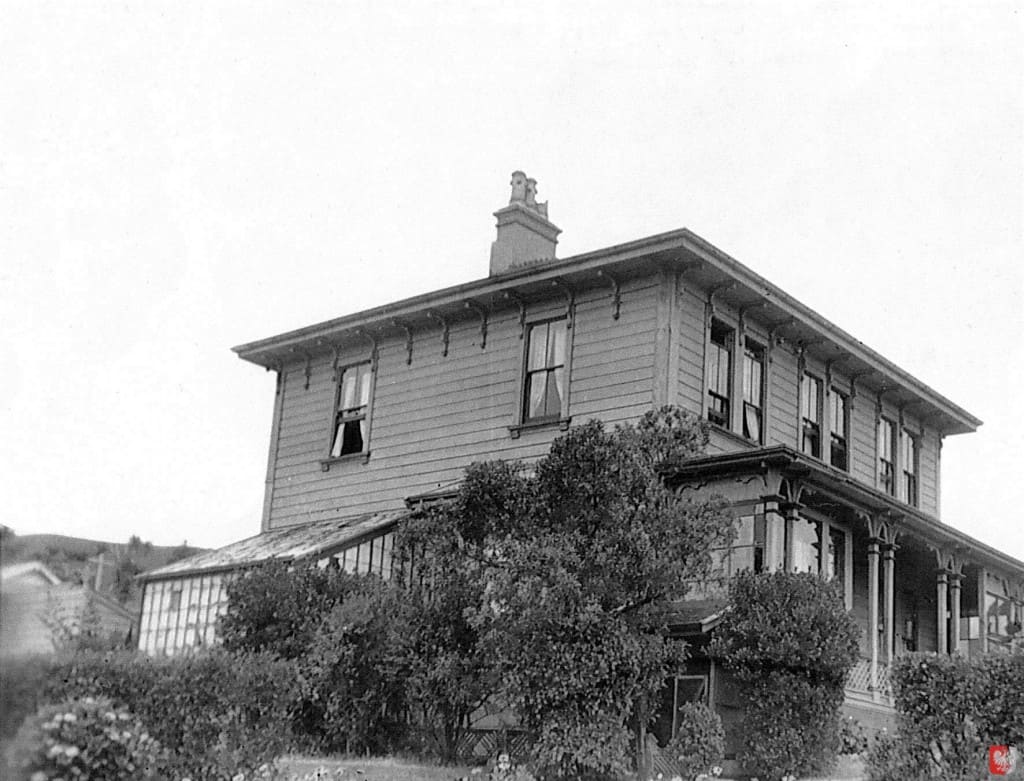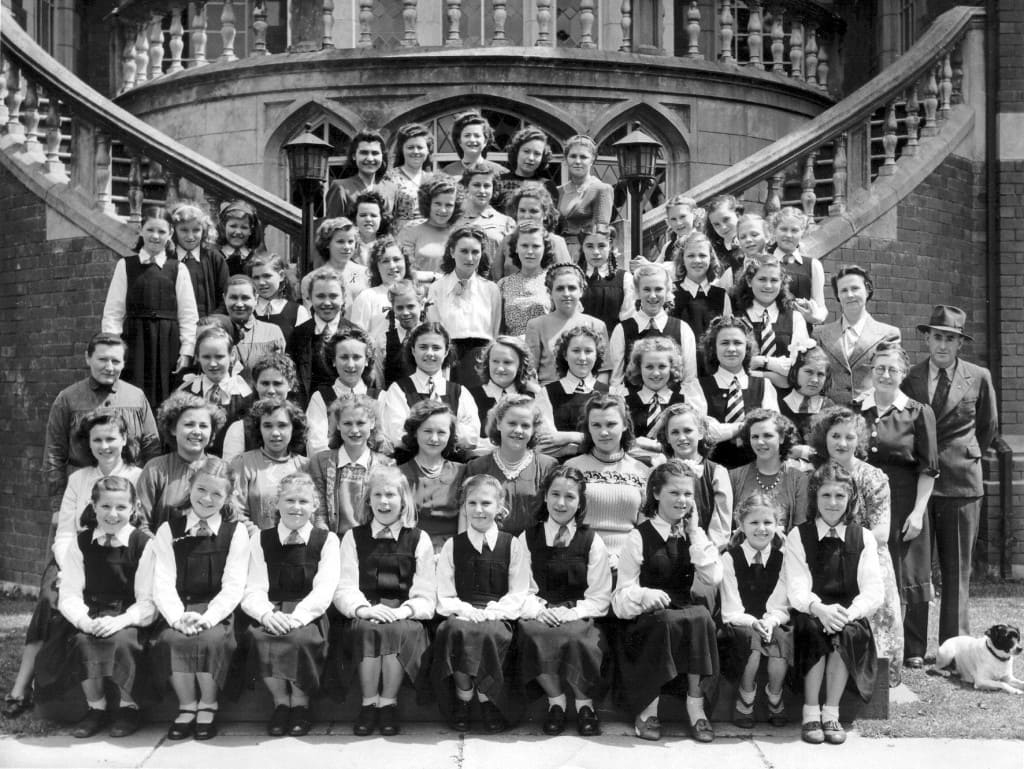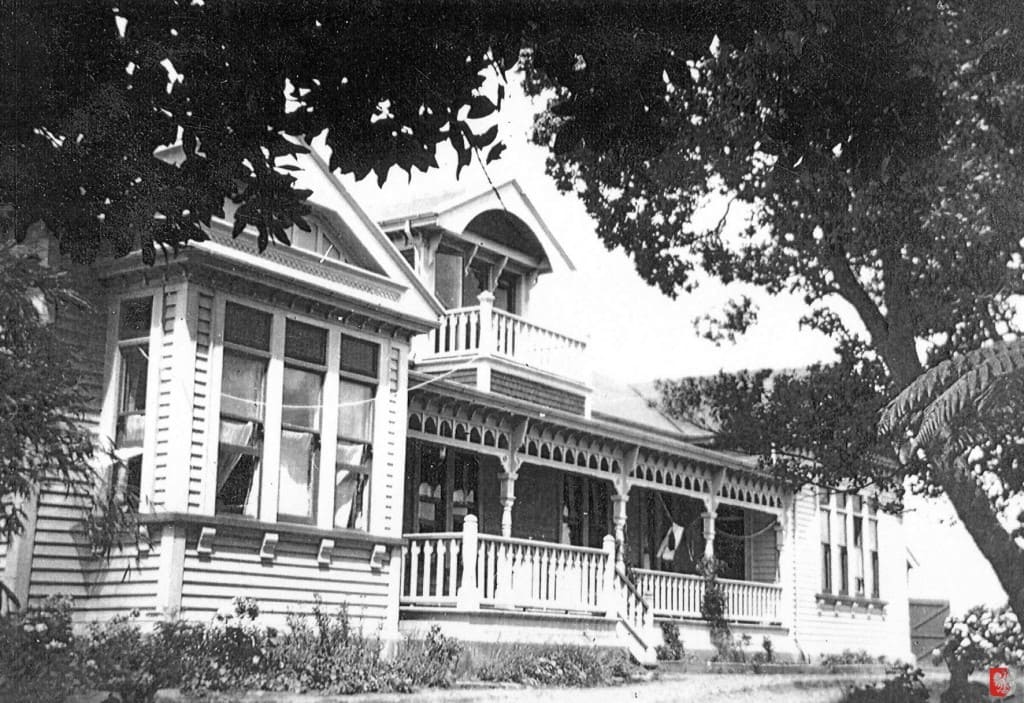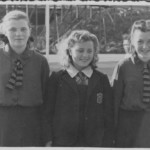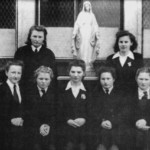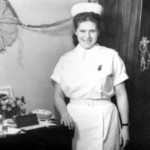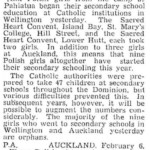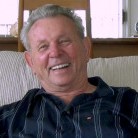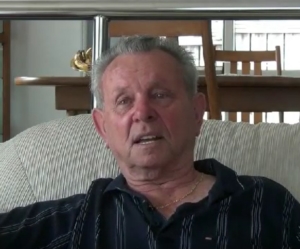Polish Refugees in New Zealand 1944-1951
Exhibitions
Leaving Pahiatua Camp

A group of senior students depart the camp for New Zealand schools in 1946. (l-r): Krystyna Skwarko (senior), Krystyna Skwarko, Elżbieta Kruszyńska, Helena Lubas, Zofia Surynt, Wanda Pelc, Leokadia Krejcisz, Eugeniusz Szadkowski, Witold Domański, Zdzisław Kaczorowski, Bolesław Żygadło, Stanisław Wójcik, Józef Kubiak, Józef Głowacz, Władysław Pietkiewicz. Source: Polish Reunion Committee 2004.
Krystina Skwarko: Poland did not regain her independence completely after the war but became a satellite of the Soviet Union. The Polish Government in London was no longer recognised. It was because of this that the Delegate of the Government, Mr Sledzinski, asked the adult community in the camp at a special meeting held on July 10, 1945, for support to continue to act not only on behalf of the Government in exile but on their behalf as well. He told us that he had received an assurance from the Polish Minister of Education, Mr Folkierski, that the necessary money for the care of the children would be supplied. (p67)
… The Polish Minister of Education instructed that the students’ from the high school in the camp were to be transferred to New Zealand convents so that the older children could obtain an education in English as soon as possible and be ready for employment. Accordingly, Mr Sledzinski advised the closure of the remaining first grade in the high school. But it was difficult for the rest of the staff to decide on such a move so the first grade class remained open until the end of 1945. (p67)
… At the beginning of the new school year in 1946, after a long period of indecision, a second group of children left for convent schools in various towns and cities [Editor’s note: The first group of children had left in February 1945]. It consisted of thirteen girls and five boys who had already completed the first grade of the Polish High School.
At the same time another group of boys and girls left to learn a trade. There were four girls (two for nursing, two for hairdressing), and nine boys (two for tailoring, two for shoemaking, four for carpentry and one for hosiery-making).
It was no problem to find board for the boys in Auckland, Masterton and Palmerston North, but it was not so easy in Wellington. It was for this reason that Father Kavanagh set up a boys’ hostel at Island Bay, which could accommodate thirty boys. Mrs Olga Laszkiewicz was put in charge of the hostel when it was first set up and the Ursuline Nun, Sister M. Aleksandrowicz, took over a few months later. (p71)
As the number of children in the camp decreased so did the number of staff. First to leave were those who preferred to work in the cities. They were followed by the wives of the ex-servicemen from Britain. Also released from their duties were the wives of men who were required to continue working in the camp until it closed. The remainder of the staff was released when the camp finally closed down. (p72)
… The Polish High School was closed in August 1946 and the students dispersed to convents throughout both islands. Another large group of children left the camp with the beginning of the new school year in 1947. Some went to convent boarding schools, others boarded privately, while attending the same schools.
It was becoming more and more difficult to find private accommodation for the girls. The problem was solved in 1947 when Father Kavanagh – who was still in charge of the Polish children in Wellington – bought a beautiful large property at Lyall Bay in the capital and transformed it into a hostel for girls. He bought the property on behalf of the Catholic hierarchy with the help of a Government subsidy and it became known as the Polish Girl’s Hostel.
Originally there was enough accommodation for 60 girls, but eventually the hostel was enlarged to such an extent that after the closure of the Pahiatua camp in 1949 it took 120 girls. (p73)
… The last group of children left the camp on April 15, 1949. It consisted of 45 boys and 45 girls. The girls went to the Polish Girls’ Hostel at Lyall Bay and the boys were taken to a special hostel in Hawera. Mrs Tietze was in charge of the boys’ hostel and Mr R. Tietze was its housemaster. (p74)
… The New Zealand Government had kept its promise as far as the education of the Polish children was concerned. Every orphan student who really wanted to continue with secondary or higher education was given the opportunity to do so. The Government gave generous allowances to pay for the board, clothing and education of these students.
However, not all the children wanted to study. After a couple of years of secondary education some of them left to find jobs, attracted by the idea of earning high wages. It was only after attempting to work for a living without any qualifications that they enrolled for night classes to get School Certificate or to learn a trade. But many of the young people not only completed study at secondary and technical schools but went on to university as well. (p76)
The Invited; p60, 71, 72, 74, 76
Voices
Voices
Before we left the camp, we were reminded that we were ambassadors for Poland. New Zealanders would look at us, we were told, and judge Polish people by the way we behaved. I felt privileged to have such an important role to play. But I also felt anxious. What was it going to be like? It seemed such a strange world. Everything would be strange: speaking English, the building, the Sisters in their black clothes, the school uniforms… . And what about the food? How was I going to manage?
Essence; p114
Then one day, one of my teachers called me and told me that I had to go to a New Zealand school because I had learned some English and could study like New Zealand school children. I was excited by the prospect of studying in a New Zealand school as I loved learning English. So a small group of four girls was dispatched to a girls’ boarding school in Timaru. A new and totally incomprehensible environment enveloped us as I became one of 100 boarders. There were strict rules with punishments attached and bells summoned us to classes, the chapel and dining room for meals.
Silence was obligatory at most times – which for me was not a problem as I could not speak English anyway. What I couldn’t understand was why speaking was such a transgression. Boarding school was interesting for the learning opportunities that were offered. I loved learning English and French, and found French much easier as I already had a foundation of the language while in Iran. But English, what a headache it was – the ever-changing grammar where each rule once learned was often displaced by an exception. What a difficult but beautiful language.
We gradually made friends with many girls who often invited us to stay with their families. This was a wonderful introduction to the warm-hearted and compassionate New Zealanders who took us in and treated us as their own children. They frequently treated us to new clothes, shoes and outings as if we were their own. Meeting New Zealand families formed a valuable link to human goodness in people everywhere and we formed lasting and enduring friendships.
New Zealand’s First Refugees: Pahiatua’s Polish Children (3rd edition); p86
Despite the fact that we still couldn’t speak English very well, we were expected to cope with the same work as the rest of the class. We also became aware that speaking in our native tongue met with disapproval. The theory being that if we spoke Polish less, we’d learn English sooner. I guess that makes sense but it didn’t work for me, because in the process I was losing my identity, and all that was Polish was an integral part of me.
New Zealand’s First Refugees: Pahiatua’s Polish Children (3rd edition); p102
I was told that I was to be sent to St Patrick’s College, Silverstream, as a boarder. I left the camp with regret and apprehension, as my happiest years were spent there. When I first arrived at the college I was homesick for the camp but had to overcome that and learn to accept everyday life at the school. The first year we played rugby and cricket alongside our lessons. It was instilled into us that they were just as important as our studies.
At the end of my first college year we were allowed to invite a partner to the annual school ball, at which we had to wear uniforms and white gloves. My partner and I made such an impression on the boys at the college that they were still talking about it six months later. She was also from the camp. She wore a white gown and danced beautifully. The experience gained by our group of Polish boys in that first year of college made it easier for other boys who followed from the camp in later years.
New Zealand’s First Refugees: Pahiatua’s Polish Children (3rd edition); p119-120
At the Polish Children’s Camp in Pahiatua I finished my primary schooling in Polish, with only one hour of English a day. My English was not fluent and my vocabulary was poor – pronouncing words, such as the “th” sounds, and spelling caused me a lot of trouble.
In 1949 I was sent to Sacred Heart College in Wanganui as a boarder. Life there was difficult and I was lonely and uncomfortable. Being separated from my friends at the camp and seldom hearing my own language was also a problem. From a confident and a bright student I became withdrawn, shy and reluctant to talk in case I said the wrong words. And of course my accent showed me up immediately.
Life was difficult. I was virtually learning three languages – Latin, French and English. My input in the class was meagre as I did not want to appear stupid. So I was given some speech lessons to help me with my difficulties. Looking back, I realise that my life and study there were beneficial and I was being prepared for the future. The school years rolled by and time gathered momentum.
New Zealand’s First Refugees: Pahiatua’s Polish Children(3rd edition); p123
Gradually the older children departed for New Zealand high schools. We were together for so long, with some for about 6 years, right from Russia. There was a bond among us. We were like one big family. For me the final parting was quite devastating when the camp was disbanded in 1949. It was like breaking up our home. Here we were, having to face another change, a culture and environment alien to us, and having to cope with another language.
Polish Kiwis; p82
The first three months in the Polish Children’s Camp in Pahiatua for six secondary-school girls was a time of intensive study which had begun in Iran and was rewarded by receiving a Polish School Certificate from the camp’s school. After the initial joy of arriving in the camp came a time of sadness, because after only three months there the first six girls, including myself, had to leave its safe and secure life for the unknown once more. What will it be like? I felt like a young bird that had to leave its nest for new horizons.
Three Catholic boarding schools made places available for two girls each. Jadwiga Brejnakowska and I were chosen for Sacred Heart College in Lower Hutt. It was a completely new environment. The language barrier was very evident, but I was determined to cope and learn, and be grateful for the opportunity. Jadwiga and I were appointed to different groups. There were fears at night and lonely moments of prayer in the school chapel, but there were also happy moments and new friendships were formed.
New Zealand’s First Refugees: Pahiatua’s Polish Children (3rd edition); p125
That first day there was another blow to my self esteem. Some local boys stood around the entrance dressed in proper school uniforms. I felt like a country yokel, still wearing the army surplus kit we wore daily at the camp a battle-dress re-dyed navy blue from its original khaki, too big for me, grey shirt, grey army socks and heavy boots. Some odd looks came my way. I expected jeers and laughter, but the boys must have been too well brought up and only gave odd glances.
I asked directions in a few words of broken English but got only stares of incomprehension. Then a group of Polish boys appeared, all dressed in the same army surplus manner – all was now OK and there was laughter and relief. I was not alone. St Patrick’s had an invasion that day of some 30 Polish boys and for most it was also their first day. We happily milled around the schoolyard together for protection, not sure what to do and trying to ignore the locals.
New Zealand’s First Refugees: Pahiatua’s Polish Children (3rd edition); p148
I was privileged to be sent to St Mary’s College in Wellington, which had very good teachers. I passed University Entrance and in 1954 commenced my studies at Victoria University of Wellington for a Bachelor of Arts. Though I passed other subjects, I failed the compulsory 50% pass rate in English. Worried and discouraged, I assumed this was because English was not my first language and that the unfamiliar grammar and idiom were at fault. But now I feel that I did not fully apply myself to all the reading required.
Also, getting by on a meagre 10 shillings pocket money a week made me decide to discontinue university. It would have been helpful if someone had explained to me my failures and advised me. But at the time I was not aware that such help existed and hope it now exists for foreign students.
New Zealand’s First Refugees: Pahiatua’s Polish Children (3rd edition); p164
In 1949 we were told that the camp was closing down and that it would be used as a transit camp for displaced persons arriving from post-war Europe.
The last of the children to leave the camp were the 42 youngest boys. I was among them and it was a disrupted school year for us. For the first school term of that year we travelled by army trucks to Mangatainoka School. For the second term we were sent to live at Linton Military Camp in Palmerston North and then to Marist Primary School. At the end of the second term we left Palmerston North and were sent to our new home in the Hawera Polish Boys’ Hostel, from where we attended St Joseph’s Primary School until the end of the year. Then we attended Hawera Technical High School.
New Zealand’s First Refugees: Pahiatua’s Polish Children (3rd edition); p170
For years, our New Zealand teachers frowned when they heard us speak Polish to one another and admonished us. To us it seemed ridiculous to speak broken English to friends of longstanding who could much better understand Polish. But our teachers must have thought that we would never learn English unless we forgot Polish. Back then, New Zealand was a very isolated country and few people travelled to Europe. There were also some people who were so conceited that they could not imagine anyone who did not speak English to be able to think intelligently….
New Zealand’s First Refugees: Pahiatua’s Polish Children (3rd edition); p179
As the children left the camp, and boarding schools and hostels, they started out on their own. For those of us who were orphans, this was an extremely difficult period of life because once we started out on our own, no one was interested in us. It was a period of loneliness and integration into “normal” life. It was at this stage that the Polish Association and community life it engendered provided a framework within which we could meet in large numbers and satisfy many of our ethnic and social needs.
New Zealand’s First Refugees: Pahiatua’s Polish Children (3rd edition); p16
I was heartbroken to leave the camp when I had to go and live in Wellington on 20 September 1946. There, I boarded with four Polish girls and 76 of other nationalities in a girls’ hostel in Oriental Bay. I started work three days later as a seamstress with three other Polish girls, travelling there by bus. Our employer was pleased with our work and showed us up as an example to the other workers – he increased their work quota based on our performance. We lived below St Gerard’s Monastery in Mount Victoria and attended Mass there regularly. Some of the local girls, indifferent until now, followed our example and became regular churchgoers. We became friendly with some Samoan, Maori and Chinese girls. After a few weeks they joined us in the church choir.
New Zealand’s First Refugees: Pahiatua’s Polish Children (3rd edition); p58-59
My classmates and I had to leave the Polish Children’s Camp in Pahiatua in 1947. Those who were considered too old to continue with their schooling were found employment. Myself and six other boys from my class at the camp were enrolled at the Marist Brothers’ High School in Greymouth. We were given board with New Zealand Catholic families and placed in the same 3rd Form class. We were and looked older than the New Zealand boys. I was 17 years old.
New Zealand’s First Refugees: Pahiatua’s Polish Children (3rd edition); p138
On 6 February 1946, two boys and six girls in their late teens (for me it was the year of my 21st birthday) were sent to Wellington to work. The boys Tadeusz Mazur and Leon Sondej were boarded out privately. The girls Wiktoria Wypych, Maria Wojciechowska, Maria Zazulak, Janina Krystman, Zofia Kornobis, Rozalia Manterys and I were given board in a hostel in Oriental Bay, Wellington. Things were not easy for us. I earned £2 10 shillings a week. For board, I paid £1 10 shillings and the weekly tram fare to work and back cost me 5 shillings. We were now fully responsible for ourselves.
Some foods were still being rationed in New Zealand. At the hostel we were also kept on rations. For breakfast we were given two slices of bread and a very small portion of butter. For lunch we could take two slices of bread with a filling and for an evening meal we were served with a piece of meat and vegetables. We were always hungry. (p203)
… The Catholic Church took an active interest. Father Tottman organised meetings for us on Tuesday evenings. Mr Scott, who helped him, invited young New Zealanders to the meetings for us to meet. However, the New Zealanders stood on one side of the room, we stood on the other and that was about all. It was so difficult to communicate. (p203-204)
… Monika Wodzicka, the daughter of the Polish Consul to New Zealand during World War II, organised us into a Polish club where we met on Sunday afternoons. Those that attended included Teresa Czochañska and Krystyna Wołyncewicz, who were boarders at Sacred Heart College in Island Bay; Wanda Rzepko and Krystyna Wojciechowska, who were working as nurse aides at a private hospital; the Polish boys working in Wellington; and we girls from the hostel. The club rooms, which belonged to the Red Cross, were in Lambton Quay across the road from Kirkcaldie & Stains. During the war the Red Cross ladies used it for storing materials and packing parcels for the soldiers serving oversea. (p204)
New Zealand First Refugees Pahiatua’s Polish Children (Third Edition); p203, 203-204,204
After the closure of the camp, I went to a New Zealand school in Palmerston North. A year later , I came to Wellington, and lived at the Polish Girl’s Hostel at Lyall Bay and attended a sewing course.
A Bouquet of Thoughts and Reminiscences; p40
At the beginning of 1948, about two weeks before school started again, the New Zealand government decided to place more of the older children into foster homes because they were now ready for high school, but there weren’t any high schools in the area. The only way for them to have their education was to put them into homes in the high school area.
So once again, it was an upsetting time for us, especially because this time quite a few brothers and sisters were separated, the older ones going off to foster homes and their younger brothers and/or sisters staying back in the camp. Although I didn’t have any brothers or sisters, I still felt very deeply for them as about half of the children in our dormitory had brothers or sisters who were going away. There were lots of tears, and we comforted each other, as we always had in times of sadness, because the adults who were in charge of us had no comfort to offer at all. To them it was just another “fact of life” and not to be concerned about, but to me, it really was a gut-wrenching experience to hear the children crying at night. I knew that they were crying because their little family had been broken apart, and like me, they were now alone in the world. I had over time, become a bit hardened to my situation, but it still really hurt when it was brought back to me that I was one of many kids who had lost their family, and had only themselves to depend on. (p104)
… We now had only two lessons a week of Polish history, the rest of our schooling was all in English, and so we were given text books in English to use. This was quite difficult, because although we could speak English well enough to get by, reading it was another matter. For the first time I found that schooling had become quite hard, and I had problems coping with this new language, as it really made very little sense to me. Reading and spelling in Polish is phonetic so you pronounce each letter the same way in any word. Once the alphabet is learned, spelling is no problem. Not so with English. Silent letters, words with different meanings spelt exactly the same way, and different sounds for letters in different words. Arithmetic became extremely difficult when we had to do “problems”, which were written sums. Ordinary sums with figures were fine for me, but with words, they were very confusing.
Mr. McKinnon decided that every morning someone had to give a “morning talk” for a minute or two. He chose the speaker at random each morning, so that even if you didn’t get to speak, you had to be prepared. At the end of the talk, the class would discuss the content, and the grammar, and any mistakes would be pointed out. In total, the talk period lasted about half an hour, and when it was my turn, I would choose my experiences at Mr. Pimm’s place as the subject. This was really quite helpful for us to improve our grammar and confidence as well. (p105)
… In Wellington, the government had established two more camps, one for boys and another for girls, so that these children would be able to carry on with their schooling from there. Our camp was to be wound down as a camp for children, and was to be used as a transit camp for all displaced families who had been sent to New Zealand from Europe.
During the August holidays (Editor’s note: 1948), those children left for Wellington, and now there were only the youngest children left behind, a total of forty-two boys and about fifty girls. Now the separation of boys and girls wasn’t as rigid as before, because the main part of the camp was to be used for families, so boys and girls dormitories were now next door to each other. Although the girls were still taught in separate classrooms, the classes were now next to each other. We were even allowed to eat our meals together in the same dining room. We got to know the girls a bit more, and became quite close in a family sort of way, as we were the only ones left from all of the children who had been together for so long.
The girls were told that they too would soon be going to Wellington, as a building for them was being prepared. Although it was very upsetting, somehow we accepted it, knowing that in time we would all probably be separated, as we grew older and went into the outside world. We boys were told that until a place could be found for us to live, we would stay in the camp but would be sent to local schools. We were sorry to say goodbye to the girls, another episode in our lives had ended. (p112)
One Man’s Odyssey; p104, 105, 112
All the Polish children of high school age are in colleges throughout New Zealand. The younger boys are in the Polish Boys’ Hostel in Hawera and the younger girls are with the older ones at the Polish Girls’ Hostel, Bursa in Lyall Bay, Wellington. Since the closing of the camp in 1949, most of the children without parents spend their school holidays with New Zealand families. They tell their hosts about their life in Poland and share their wartime stories.
Essence; p141
Meanwhile, the Polish Children’s Camp at Pahiatua had almost served its purpose as the older children were now assuming the responsibilities of young, working adults. Some of the children had now been reunited with their fathers, older brothers and cousins, most of whom were Polish ex-servicemen from Britain. They too were resettled in New Zealand after World War II, when the Polish army was demobilised. Many of these new arrivals settled with their families in Wellington. A Polish boys’ hostel was established for the young working men in Hawera and in Island Bay in Wellington. In 1947 Father Kavanagh, the Catholic priest in charge of Polish children in the capital, purchased on behalf of the Catholic church, a large property at Lyall Bay, ‘Ngaroma’. A government subsidy was made available for the new Polish girls’ hostel for young, working women. This large, stately home was transformed into accommodation for 60 girls initially, and after the closure of the Pahiatua Camp in 1949, it was enlarged to cater for 120 boarders. The last group of 90 children left the Pahiatua Camp on 15th April 1949. To ensure the welfare of all the remaining orphans, Mrs. Ellinor Zaleska was appointed their guardian, through the Child Welfare Branch of the Department of Education in Wellington. She continued her dedicated work until April 1956. She was the wife of the late Polish diplomat S. Zaleski, who was appointed by the Polish Government-in-Exile in London to be the delegate of the Polish Children’s Camp at Pahiatua. That position was later filled by his wife, after his sudden death In Wellington.
An Unforgettable Journey; p129-130
Leaving the camp was heartbreaking, as if our home and family was being split up. I and two other girls went to a convent school in Wanganui and, suddenly, we became a very small minority group. The nuns and the girls were kind, but we were strangers. Everything was alien – the food, the language, the customs. At first we felt the burden of our Polishness – that we had an obligation to live up to the expectations of those who reared us in the Polish heritage.
In time, however, we began to feel we wanted New Zealand to be proud of us also. We were determined to make use of the opportunities we were given. It became a natural part of our lives to feel we had a dual role. It was a time of adjustment. The school began to benefit from our presence also: we shared our Polish culture, our experiences, values and attitudes. New Zealand families invited us into their homes and we gave them all we stood for, in return.
It continued to be a difficult period for the Polish women. Many felt responsible for the children’s guidance and future in New Zealand. Some had to adjust to widowhood and all had to face an uncertain future. The relatively secure and familiar life of the camp was replaced by the need to start afresh in a strange environment. Finding work and accommodation when they also had language problems and no New Zealand qualifications must have seemed a mammoth task. The fact that they did make a place for themselves in New Zealand is a verification of New Zealand hospitality, as well as their own stamina and courage.
Voices of Refugee Women; p40
The camp was slowly becoming deserted as students were sent out to various Catholic schools all over New Zealand. Children fourteen years of age and older were moved to boarding schools while the younger ones were placed with New Zealand families.
As the real age of the children was often hard to ascertain due to the lack of documents showing their date of birth, and also because many didn’t know when they were born, once a year the supervisor applied his own method of separating the men from the boys. At the barracks assembly Mr Kozlowski would order his charges to pull down their pyjamas pants. He would then glance at each boy in turn and divide them into two groups. Those with any signs of pubic hair were moved to an older age group.
Finding homes for several hundred youngsters was no mean task. Bishop O’Shea in consultation with other church leaders and the management board of the Pahiatua camp asked the New Zealand Catholic community for help. Priests throughout the country began appealing from the pulpit to their parishioners to take care of a Polish orphan. Many New Zealand families responded, opening their homes and hearts to the Polish children.
With decreasing numbers of students, the demand for teachers and caregivers also diminished. They too started to leave the camp to begin a new life in places scattered around New Zealand, wherever job opportunities took them.
At last it was Tony’s turn to leave. He was told that on the 2nd February 1949 he was to go to Christchurch to a New Zealand family who had agreed to foster him. The group leaving the camp consisted of about eighty boys and girls, all destined to go to different parts of the South Island – Christchurch, Timaru, Oamaru, Dunedin, and even Invercargill. (p196-197)
… The eighteen young Poles from Pahiatua were gradually assimilated into Kiwi life. The girls went to the Sacred Heart College by the Catholic Cathedral in Barbadoes Street. Xavier College next door was attended by the boys – Czesiek Bełczynśki, Nikifor Piesocki, Stan 0ściłowski, Romek Kraj, Piotr Adamczyk and Tony Leparowski.
Stan, Romek and Niki lived in a very old house in Connal Street, Woolston, with their foster parents Mr and Mrs Bowbore. The three boys shared the Sumner Express ride with Tony to and from school, getting off at Bamford Street on their way home, while Tony continued on to Moncks Bay. The foursome soon became inseparable and were nicknamed “the four musketeers ” by those who knew them.
Tony quickly adjusted to the new routine. Xavier College was a single-sex school where all teachers were priests. The discipline was similar to that at the Pahiatua camp, so he found it easy to conform with. His classmates were also not unlike some of the Polish boys he knew, sharing the same love of making fun at the expense of others. (p211-212)
… When the holidays started Tony and his three friends went to Wellington on the Lyttelton ferry. A few days later they started working at Eveready Batteries. This was a real school of life for them. They had to get up at five in the morning, eat breakfast and make lunches to take to work. At six they caught a tram to the city to reach the factory gates before seven. And what a tough job this was! Shifting bags of coal and graphite from one end of the factory to another, carrying the heavy bags on their backs. (p228)
… Soon after he returned to Christchurch Tony’s life took yet another unexpected turn when Jack and Elizabeth made a sudden announcement. “Tony,” Jack said one evening, “We have sold our grocery store and brought a house in St Albans.” … “What about me? WIll I still go to Xavier College?”
“No, we had to shift you to St Bede’s College. We have arranged a place for you in a boarding house.” (p231)
… The change was a painful blow to Tony. After two years of living with the Houlahans he had begun to feel safe and settled. He loved his sunny room above the shop in Moncks Bay. He enjoyed the proximity to the sea and the hills behind the shop. He felt that Jack and Elizabeth had accepted him as their own son. But their decision had left him dazed and confused. He was now separated from his closest friends and put in a boarding school at the far end of the city. From the comfort of his bright and spacious bedroom he was transplanted to an eighty-bed dormitory.
Alone: p196-197, 211-212, 228, 231, 233
There is room here to record only a few snippets of memories of the working youth from their first early days in a new environment in which everything was foreign to them: the language, the manners and the living conditions. The sources of these memories are Maria Wypych (nee Węgrzyn), Władysłraw Miliszewski, Leon Sondej and Zdzisław Kaczorowski. Although 66 years have passed since those days, their memory of these difficult beginnings in New Zealand’s capital city is very vivid.
The boys were placed in ones and twos in private homes with New Zealand families. The billeting was aranged by Fr. Patrick Kavanagh on behalf of the Catholic Church which had initial care over the Polish arrivals. He was the parish priest of Newtown’s St. Joseph’s church, and for this reason most of the boys were first billeted with his parishioners. Some of the girls were placed temporarily in the YWCA hostel in Oriental Bay. Girls of school age were sent to St Mary’s College.
Those working paid about 30 shillings per week for board and accommodation. They ate the same as their landlords. For the evening meal they had mutton with mashed potatoes etc. Dessert was custard or bread and butter pudding. Sandwiches for lunch to work had slices of beetroot, perhaps a slice of corned beef or a slice of luncheon sausage. The New Zealand cuisine in those days was very basic. World War II was just coming to a close, so there were still food shortages, because much of it was sent to the soldiers on overseas service. Therefore much of the food could be bought only with ration cards. Those boys who had fulIboard with families ate better than girls who boarded temporarily in the YWCA hostel, which provided skimpy meals. The girls went hungry. Often a piece of bread with a thin spread of butter and jam served as a simple meal for the working girls. After Siberia their diet improved in Iran and in the Pahiatua Camp. Here they were hungry again. Poor wages did not allow for the purchase of extra food. They fared better when they went to board privately with New Zealand families in the city.
Girls working in the tailoring trade earned two pounds (40 shillings) per week and the board and accommodation cost some 30 shillings per week, or three quarters of their wage. After paying for tram tickets to work from the left over 10 shillings, little remained for other necessities, such as clothing. They could not afford the train fare to the Pahiatua Camp for the Christmas holidays, for which they waited so eagerly. Shortage of money for fuel meant that a bath could be had only once a week, usually on a Saturday. One first had to light a fire to heat the water in a copper cauldron, often located in an outhouse. The hot water had to be carried to the bathroom in buckets.
The boys arrived in Wellington in short trousers which were sewn by the girls’ sewing classes in the Pahiatua Camp. The boys’ jackets were army-issue battle dresses, army overcoats and army boots and socks, in which they were an eye-catching sight in the streets of Wellington. A new pair of long trousers cost 15 shillings.
One of the boys remembers how a group of them were brought to Wellington by train well before their permanent arrival there, to familiarise them with their future living conditions and the working environment. A Mr Rankin from the Department of Labour took them around various factories and places of employment. They knew only a few words of English, such as “she”, “he”, “is” which they were first taught in Iran. There was a severe shortage of workers in those post-war years and many employers posted “Job vacancies” signs on the front of their premises. Many paid 5 pounds (two week’s wages) for those who introduced a new employee.
Tramcars were the most common means of transport.
After a time, the boys had saved up to buy bicycles for travelling to work and to meet their Polish pals, often on street comers, such as the intersection of Manners and Cuba streets .. The boys did not meet in their rooms, because such visits were not welcomed by the landlords, although there were exceptions. Some of them worked at Prestige in Home St, one remembers working in a tailor workshop in Panama St where two of them became apprentices. These boys travelled by train from Pahiatua by themselves. At railway station they were met by the workshop’s accountant who took them by tram to their lodgings in Brooklyn. He then showed them how to catch the tram to work in town. He bought them each a ten trip tram ticket, after which they were to buy their own.
After work he accompanied the boys to a tram stop for Brooklyn and from then on they were left to their own devices. On Saturday afternoons they played rugby. After six months the tailor gave them a rise in wages, but even that was not enough for the basic needs, after paying for the room and full board. There was not enough for the full tram ticket so they walked to work.
For Christmas and other holidays the Polish youth travelled back together to the Pahiatua Camp till its closure, if they could afford the train fare. It was like going back home. The train joumey was a time of joy during which they sang Polish songs with great enthusiasm.
There was a priest in Seatoun, Fr. Burke, who apparently understood Polish, so they went to him to hear their confession. It is not certain if he did understand, because absolution was given in English.
The Mt Cook Polytechnic next to the old museum held evening classes in English for foreigners, among them a few Poles and Romanians. The teachers were of course New Zealanders who spoke no Polish. One of the boys remembers an older Irish lady teacher who taught them to sing ‘When lrish Eyes are Smiling’.
With the help of the Catholic church authorities a Polish Youth Club was formed in the city centre in Lambton Quay, on the first floor next to a Greek restaurant, opposite the Midland Hotel (which is now a park of that name). Some 30-40 Polish boys and girls attended the club. Apparently the free use of the club rooms for the Polish youth was personally arranged by Prime Minister Peter Fraser. He also paid visits to the club. There were three rooms with a kitchen and toilet facilities, with some basic furniture with a settee, chairs and tables.
A Madame Malanger looked after the premises with the help of the older girls, though the boys also helped out. The rooms were free of charge. Dances were held there, to the accompaniment of 78rpm records played on a hand-cranked gramophone. Each record (some 10 of them) played for three minutes. After playing three such records, the needle became blunt and had to be changed. The music played was waltzes and such melodies as Blond Sailor.
Newsletters, which were produced on a Gestetner copier by Ray Scott, a friendly New Zealander. Fr Kavanagh set up a shop in the clubrooms which sold Polish handicrafts produced by the younger Polish girls who remained in the Pahiatua Camp. The expenses incurred to hold the dance evenings were met out of donation from those attending, which amounted to 3 pence, the equivalent of small serving of takeaway fish and chips. One boy remembers the Polish first New Year’s dance in Wellington. The father of his New Zealand friend was a hotel owner in Taranaki St. He generously allowed the Polish youth to hold their dance in one of the hotel rooms. He even donated a crate of beer and lemonade for the occasion. They had a most enjoyable year end celebration. A similar club was established in Auckland.
The first Polish picnic was held in 1947 at St.Patrick’s College in Silverstream. Some 20 young people attended – the ex-soldiers of the Polish Army in Exile had not yet arrived in New Zealand. Each person was provided with a bag of sandwiches and fruit, prepared by a Mrs Harrington.
When the ex-soldiers arrived in 1948, they set up the Association of Poles in NZ (Inc). The first extraordinary meeting of Polish people in Wellington was held in the Dominion Farmers’ Institute in Featherstone St. … .Prior to this there was already in existence a Polish Association in Wellington, which was set up by Jews from Poland prior to World War II. They decided to disband and to merge their organisation with the new one, and passed on their remaining small funds and structure to the association. Some of them joined the new association, and a few became active members of the new committee. The first secretary became Kazimierz Wala, who knew some English. The adults hoped that they could have the use the Youth Club premises. But the new Prime Minister Sidney Holland was of the opinion that the Poles should now manage for themselves. The authorities took the opportunity and closed the Polish Youth Club.
Once the Polish Association established itself and the rest of the children left the Pahiatua Camp, new Polish Youth Clubs were formed in Wellington, Auckland and Christchurch under the auspices of the Association.
Wiadomości – October 2012, p9-20 *
*Magazine edited by the Polish Association in New Zealand
Photos
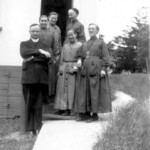
Documents
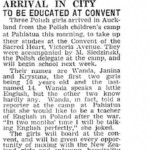
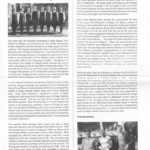
Testimonies
Acknowledgements
The New Zealand Museum Gallery Room “Polish Refugees in New Zealand – Deportees Forcibly Taken to Siberia, Ex-Servicemen and Displaced Persons” was created by a workgroup from Wellington, New Zealand under the umbrella of the Kresy-Siberia Foundation. The group was led by Irena Lowe (Smolnicki), and assisted by Dr.Theresa Sawicka, Wesław Wernicki, Jackie Rzepka, Adam Manterys and Mary-Anne Morgan (Baziuk).
Theresa and Wesław have provided the team with professional assistance in the field of history. Irena, Jackie, Adam and Mary-Anne are all first generation New Zealanders and descendants of family members forcibly deported from Kresy during World War II, who subsequently came to New Zealand either as children bound for Pahiatua Children’s Camp, or as ex-servicemen and women or displaced persons.
We also acknowledge all those Pahiatua children and adults, ex-servicemen and women, displaced persons and New Zealanders who have written about their own or their family’s experiences in books and journals and provided a wonderful history in text, photos and documents over many decades. The team has not set out to rewrite the history but rather to collate the existing stories in a structure so that the interested readers and the following generations can access the stories on-line and view the history as a mosaic. We are humbled by their experiences.
We are grateful to our sponsors who have enabled the publication of this gallery.

Stowarzyszenie Polskich Kombatantów SPK (Polish Ex-Servicemen’s Association)
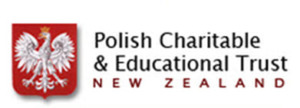
Polish Charitable and Educational Trust New Zealand

The Morgan Foundation

Dr Zbigniew Popławski – in memory of the Popławski family
Andy and Anthony Bogacki – in memory of the Bogacki and Zielinski family
Eugenia Smolnicka – in memory of Michał and Antonina Piotuch
Jackie Rzepka – in memory of the Rzepka family
Steve Witkowski – in memory of the Witkowski family
Bibliography
Sources
Alexandrowicz, S.Monica 1998. “Z Lubcza na Antypody“. Seria: Ocalić od zapomnienia -1. Zgromadzenie Siótr Urszulanek SJK.
Beaupré-Stankiewicz, Irena, Danuta Waszczuk-Kamieniecka, and Jadwiga Lewicka-Howells. 1989. Isfahan – City of Polish Children. 3rd ed. London: Association of Former Pupils of Polish Schools, Isfahan and Lebanon.
Beaupré-Stankiewicz, Irena, Danuta Waszczuk-Kamieniecka, and Jadwiga Lewicka-Howells. 1987. Isfahan – Miasto Polskich Dzieci. 1st ed. London: Kolo Wychowanków Szkól Polskich, Isfahan i Liban.
Chibowski, Ks. Andrzej. 2012. Kapłańska Odyseja Ząbki. Original language edition. Polska: Apostolicum.
Chibowski, Dr. Andrzej. 2013. A Priest’s Odyssey. 1st English- language edition. Wellington, New Zealand: Future Publishing.
Dabrowski, Stanislaw. 2011. Seeds in the Storm. Waikanae, NZ: Maurienne House.
Ducat, Michelle, Mealing, David, Sawicka Theresa, and Petone Settlers Museum. 1992. Living in Two Worlds: The Polish Community of Wellington Wellington: Petone Settlers Museum/Te Whare Whakaaro o Pito-one
Jagiello, Józef. 2005. One Man’s Odyssey. Edition 2005. Józef Jagiello.
Department of Labour, New Zealand Immigration Service. 1994. Refugee Women: The New Zealand Refugee Quota Programme. Wellington: Department of Labour, New Zealand Immigration Service.
Lowrie Meryl. 1981 The Geneva Connection, Red Cross in New Zealand. Wellington: New Zealand Red Cross Society.
Manterys, Adam, Stefania Zawada, Stanislaw Manterys, and Józef Zawada. 2008. New Zealand’s First Refugees: Pahiatua’s Polish Children (2nd ed.). Wellington: Polish Children’s Reunion Committee.
Manterys, Adam, Stefania Zawada, Stanislaw Manterys, and Józef Zawada. 2012. New Zealand’s First Refugees: Pahiatua’s Polish Children (3rd ed.). Wellington: Polish Children’s Reunion Committee.
Manterys, Adam, Stefania Zawada, Stanislaw Manterys, and Józef Zawada. 2006. Dwie Ojczyzny: Polskie dzieci w Nowaj Zelandii Tułacze wspomnienia. Warszawa: Społeczny Zespól Wydania Książki o Polskich Dzieciach w Nowej Zelandii.
New Zealand Education Deptment. 1945. “Polish Children in New Zealand.” New Zealand School Journal, 1937-vol. 39 No 5, Part III:147-152.
Polish Women’s League. 1991. Wiązanka myśli i wspomnie / Koło Polek = A Bouquet of thoughts and reminiscences. Wellington, N.Z.: The League.
Rodgers, Owen. 2011. Adventure Unlimited – 100 years of Scouting in New Zealand 1908-2005. Wellington: Scout Association of New Zealand.
Ronayne Chris. 2002. Rudi Gopas – a biography. David Ling Publishing Limited.
Skwarko, Krystyna. 1972. Osiedlenie Młodzieży Polskiej w Nowej Zelandii w r. 1944. Londyn, Poets’ and Painters’ Press.
Skwarko, Krystyna. 1974. The Invited. Wellington: Millwood Press.
Spławska, Władysława Seweryn. 1993. Harcerki w Zwiądzku Harcerstwa Polskiego: Poczatki i Osiągnięcia w Kraju oraz 1939-1949 poza Krajem. Głowna Kwatera Harcerek ZHP poza Krajem.
Suchanski, Alina. 2006. Polish Kiwis: Pictures from an Exhibition. Christchurch: Alina Suchanski.
Suchanski, Alina. 2012. Alone : an inspiring story of survival and determination. Te Anau, N.Z.: A. Suchanski.
van der Linden, Maria. 1994. An Unforgettable Journey. Second Revised ed. Palmerston North: Dunmore Press.
Tomaszyk, Krystine. 2004. Essence. Palmerston North: Dunmore Press.
Tomaszyk, Krystyna. 2009a. Droga i Pamięć: Przez Syberie na Antypody. Warszawa: Wydawnictwo Trio.
Zdziech, Dariusz. 2007. Pahiatua – “Mała Polska” małych Polaków. “Societas Vistulana” .
Other Books
Beck, Jennifer, and Lindy Fisher. 2007. Stefania’s Dancing Slippers. Auckland: Scholastic New Zealand. [Children’s Book]
Domanski, Witold (Vic). 2011. A New Tomorrow: A story of a Polish-Kiwi family. Masterton, NZ: Tararua Publishing.
Jaworowska, Mirosława. 2011. Golgota i Wybawienie: Dzieci Pahiatua od Syberii do Nowej Zelandii – Cztery Pory Roku jak Cztery Pory Życia Warszawa: Studio Jeden.
Kałuski, Marian. 2006. Polacy w Nowej Zelandii. Toruń, Poland: Oficyna Wydawnicza Kucharski.
Lochore, R. A. 1951. From Europe to New Zealand: An Account of our Continental European Settlers. Wellington: A. H. & A. W. Reed in conjunction with the New Zealand Institute of International Affairs.
Lubelski, Katolicki Uniwersytet. 2007. Z Sybiru na drugą półkulę : wojenne losy Polskich dzieci z Pahiatua. Lublin: Wydawn. KUL.
Pobóg-Jaworowski, J. W. 1990. History of the Polish settlers in New Zealand, 1776-1987. Warsaw: CHZ Ars Polona.
Ogonowska-Coates, Halina. 2008. Krystyna’s Story: A Polish refugees journey. Dunedin: Longacre Press.
Roy-Wojciechowski, John, and Allan Parker. 2004. A Strange Outcome: The Remarkable Survival Story of a Polish Child. Auckland: Penguin Books.
Szymanik, Melinda. 2013. One Winter’s Day in 1939. Auckland: Scholastic. [Children’s Book]
Turol, Sophia. 2010. Sophia’s Challenging Journey: Self-published.
Wiśniewska-Brow, Helena. Give Us This Day. Victoria University Press.
Other Materials
CraftInc. Films. 2015. Polish Children of Pahiatua. 70th Reunion – HD. Wellington: CraftInc Films. Produced by Wanda Lepionka and David Strong. [Film].
Gillis, Willie Mae. 1954. The Poles in Wellington, New Zealand. Edited by Department of Psychology. Vol. No. 5 Publications in Psychology. Wellington: Victoria University College. [Research]
Krystman-Ostrowski, Teresa Marja. 1975. The Socio-Political Characteristics of Polish Immigrants in Two New Zealand Communities, Department of Politics, University of Waikato, Hamilton. [Thesis]
National Film Unit. 1944. Weekly Review 169. Wellington: National Film Unit.
O’Brien, Kathleen. 1966. The Story of Seven-Hundred Polish Children. Wellington: New Zealand National Film Unit. [Film]
Ogonowska-Coates, John Anderson in collaboration with Halina. 1996. Exiles: The Story of a Polish Journey. Wellington: Ace of Hearts Production in Association with Polish Television. [Film]
Sawicka-Brockie, Theresa. 1987. Forsaken Journeys, Department of Anthropology, Auckland University, Auckland. [PhD Thesis]
Stowarzyszenie Polaków w Christchurch. 2004. Poles Apart: Historia 733 Polskich Sierot. Christchurch: Canterbury Telivision (CTV). [Film]
Tomaszyk, Krystyna. 2009b. The Story of the Polish Children in Isfahan – Iran 1942-1944. [DVD]
Indexes Of Names
Dundalk Bay – Ship carrying Displaced Persons to New Zealand
Goya Voyage 2 – Ship carrying Displaced Persons to New Zealand
Goya Voyage 3 – Ship carrying Displaced Persons to New Zealand
Orphanage – Pahiatua – New Zealand
S.S. “RANGITIKI” – Ship carrying ex-servicemen related to Pahiatua orphans to New Zealand
SS Hellenic Prince – Ship carrying Displaced Persons to New Zealand
Contact
Kresy-Siberia (New Zealand)
PO Box 853 Wellington 6140 New Zealand
e-mail: NZ@Kresy-Siberia.org
